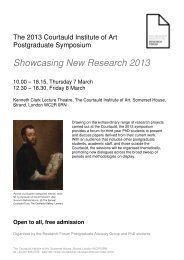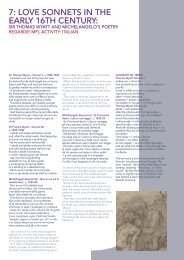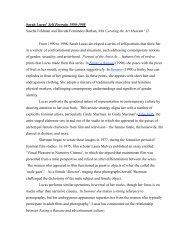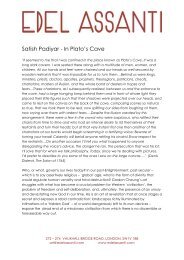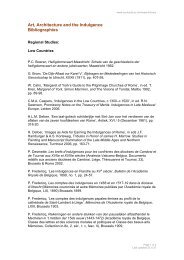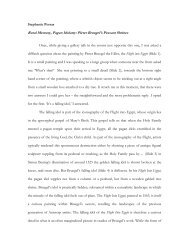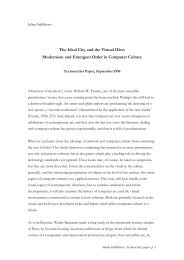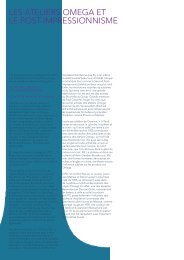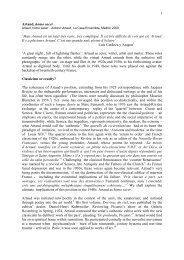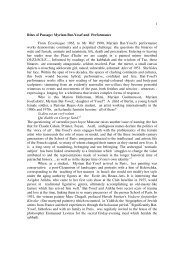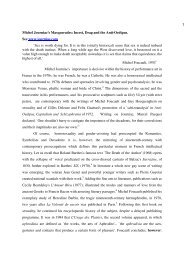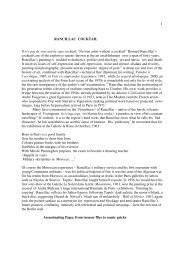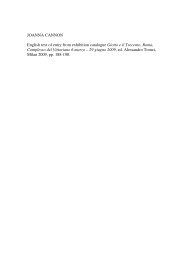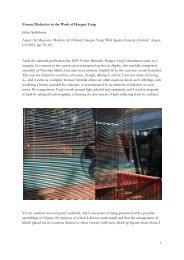Iluna gordelekuan/ Oscuridad en el refugio - The Courtauld Institute ...
Iluna gordelekuan/ Oscuridad en el refugio - The Courtauld Institute ...
Iluna gordelekuan/ Oscuridad en el refugio - The Courtauld Institute ...
You also want an ePaper? Increase the reach of your titles
YUMPU automatically turns print PDFs into web optimized ePapers that Google loves.
w<strong>el</strong>l as much which is ugly, malformed and vicious. . . . It is a mirror for contemporary man<br />
to gaze into [...].’ 28<br />
Mutilation might be a positive feature, but if it is not the mutilated soul of<br />
Moore is no more than a reflection of our own.<br />
<strong>The</strong> argum<strong>en</strong>t about mutilation turns around whether we see the pieces as metal, stone<br />
and wood, or as flesh its<strong>el</strong>f. <strong>The</strong> hardness of Moore’s material, the way that it r<strong>en</strong>ders flesh,<br />
is oft<strong>en</strong> tak<strong>en</strong> to reflect the hardness of Moore’s s<strong>en</strong>sibility. One critic wrote of the figures in<br />
Moore’s drawings playing at being turned into stone, at being statues, for their surface is<br />
harder than the substance of flesh. 29<br />
<strong>The</strong> 1951 Tate Gallery exhibition catalogue associated<br />
Moore’s metaphorical substitution of bones, pebbles and sh<strong>el</strong>ls for parts of the body with his<br />
imagination ‘obsessed with what is hard, strong and stony.’ 30<br />
Bryan Robertson dealt with the issue of the fleshiness of Moore’s work in 1961. Only<br />
rec<strong>en</strong>tly, he claimed, had the artist come to terms with r<strong>en</strong>dering flesh, previously there had<br />
be<strong>en</strong> just bone, rock and fossil, and this somehow fitted in with the retic<strong>en</strong>t, almost cerebral,<br />
‘dispassionate coldness’ of the artist’s nature. Such work is tough, compressed and vital but<br />
lacks warmth, and ev<strong>en</strong> the Sh<strong>el</strong>ter drawings which are the result of strong emotion are<br />
‘fierce, grim studies’ which make no concession to s<strong>en</strong>tim<strong>en</strong>tality or pathos. 31<br />
If we read the<br />
material as stone it is a sign of Moore’s coldness, if we read it as flesh it is a sign of<br />
mutilation.<br />
Wight says that Moore eviscerates the figure carving away all the soft parts and leaving<br />
only hard forms. <strong>The</strong> chest or breast is the feeding ground of the child and from the child’s<br />
point of view it is natural that it should be eat<strong>en</strong> away. 32<br />
While many of the interiors of the<br />
H<strong>el</strong>met Heads appear mechanical or sk<strong>el</strong>etal, Head: Cyclops, 1963 (LH 507), contains a<br />
slug-like form that could hardly be more fleshy. Here is an almost programmatic<br />
combination of hard and soft.<br />
<strong>The</strong> curr<strong>en</strong>t of negative fe<strong>el</strong>ing about Moore’s subjects did not go unopposed. <strong>The</strong>re<br />
was certainly a strong tr<strong>en</strong>d in contemporary criticism towards defusing the fright<strong>en</strong>ing<br />
nature of Moore’s work, and this applied as much to those who attacked it as to those who<br />
praised it. <strong>The</strong> most common av<strong>en</strong>ue of attack, ev<strong>en</strong> from his admirers, was the charge of



